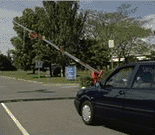

Personnel or Vehicle ID
Overview
BALOGH HyperX™ is a long range (2.45 GHz) Identification System with read distances ranging from 0.5 meters to 10 meters (FCC approved up to 5 meters). HyperX™ uses semi-passive read-only tags that utilize the power from the antenna for data communications that provides fast and reliable identification with tag reading speeds at up to 60 mph, and very little interference concerns. It is the premier system for hands-free access control and automatic vehicle identification (AVI).
OPERATING PRINCIPLE
The HYPER X™ readers emit electromagnetic waves in the 2.45 GHz band. A non-modulated carrier wave is generated by the reader and reflected by HYPER X™ tags. This incident beam is modulated during the reflection in accordance with the identification code of each tag. This operating method allows long tag lifetimes and identification ranges of several meters.
TAGS
The HYPER X™ tags contain a battery which powers the onboard electronics. This battery is not used for the generation of RF energy. HYPER X™ tags are semi-passive. HYPER X™ tag lifetimes are constant and independent of tag usage. The reading distance for all HYPER X™ tags is constant and independent of age, for a given reader.
READERS
The readers are chosen in regards to the defined identification area and the reading distance required. The electromagnetic emitted energy determines the reader range. (0.1m to 10m) and the antenna design determines the beam cone geometry (90° x 90° 45° x 45°; 22° x 45°) identification zone.
ENVIRONMENTAL NOISE IMMUNITY & COMPATIBILITY
Immunity: emission of 2.45 GHz RF waves must comply with industry standards and is strictly controlled. The emitted powers are very low so as not to disturb other electronic equipment. Compatibility: the readers are subjected to radio interference at many different frequencies. Interfering radiation outside of the working band is rejected. Most of this, particularly that from industrial machinery, lies below 500 MHz and usually does not adversely affect system operation.
